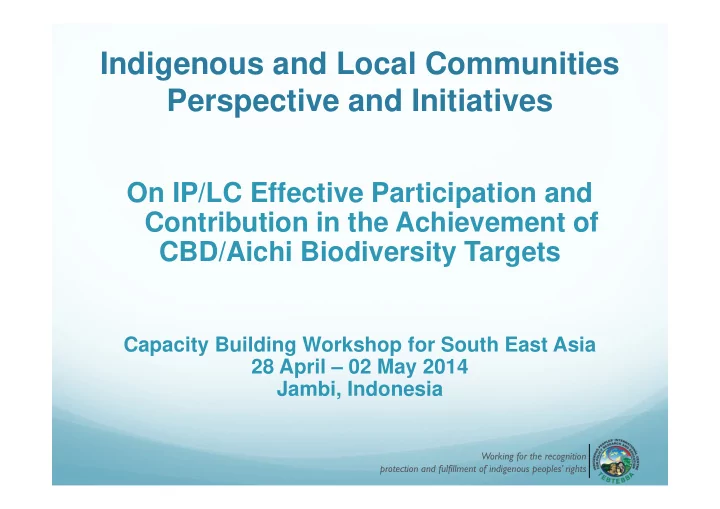

Indigenous and Local Communities Perspective and Initiatives On IP/LC Effective Participation and Contribution in the Achievement of CBD/Aichi Biodiversity Targets Capacity Building Workshop for South East Asia 28 April – 02 May 2014 Jambi, Indonesia Working for the recognition protection and fulfillment of indigenous peoples’ rights
Introduction: IIFB and IIPFCC Tebtebba (Indigenous Peoples International Centre on Policy Research and Education) As one of the active members of: � International Indigenous Forum in Biodiversity (IIFB) as IP Caucus in CBD; and � International Indigenous Forum on Climate Change (IIPFCC) as IP Caucus in the UNFCCC As IP networks for effective IP engagement in UN processes and follow-up on the implementation of agreements at national/subnational levels Working for the recognition protection and fulfillment of indigenous peoples’ rights
4 TK indicators agreed in the CBD 2006: CBD-COP10 agreed on 4 Indicators on traditional knowledge � Status and trends of linguistic diversity and numbers of speakers of indigenous languages; � Status and trends in the practice of traditional occupations; � Status and trends in land-use change and land tenure in the traditional territories of indigenous and local communities; � Trends in which traditional knowledge and practices are respected through their full integration, safeguards and the full and effective participation of indigenous and local communities in the national implementation of the Strategic Plan. Working for the recognition protection and fulfillment of indigenous peoples’ rights
Other agreements in CBD/UNFCCC processes � Achievement of Aichi Goals and Targets thru participatory planning, knowledge management and capacity building (with integration of TK, innovations and practices and with the full and effective participation of ILCs at all relevant levels) � Addressing REDD+ (including the role of conservation, sustainable management of forests; and enhancement of forest carbon stocks) Cancun Safeguards including; � respect and recognition of the knowledge and rights of IPs (noting the UNDRIP) � full and effective participation of relevant stakeholders including IPs and local communities � actions are consistent with the conservation of natural forests and biological diversity, and not used for the conversion of natural forests, but are instead used to incentivize the protection and conservation of natural forests and their ecosystem services, and to enhance other social and environmental benefits Working for the recognition protection and fulfillment of indigenous peoples’ rights
Initiatives of Global Indigenous Peoples Partnerships on CC, Forests and Sustainable Development at Local Level � Implementation of the integrated and holistic approach to sustainable development which includes: � Human rights-based approach to development � Ecosystem, landscape and/or territorial management approach � Knowledge-based approaches including science, diverse cultures, traditional knowledge, innovations and practices � Gender-sensitive and intergenerational approach � Economic sustainability and sufficiency thru support and enhancement of diverse local economies and livelihoods Working for the recognition protection and fulfillment of indigenous peoples’ rights
Initiatives as Contribution to the CBD/Aichi Targets, REDD+ Safeguards, and SD/PR • Awareness raising and Capacity Building for IPs related to HR/IPR, CC, BDV, EA, SD, etc. from Global to local • Researches/case studies on customary governance on TFM/TNRM, the role of indigenous women on TFM/TNRM, and on access and benefit sharing • Participatory community mapping in IP customary lands and forests/ecosystems on land-use/land-use changes, including biodiversity resource inventories and carbon accounting – with overlaps with PAs • Pilot projects on enhancement of TK, innovations and practices on ecosystems restoration and resilience, sustainable use and management of biodiversity resources, and enhancement of traditional livelihoods as contribution to CC adaptation and mitigation, and SD/PR • Participatory and community-based management, monitoring and information systems (CBMIS) and evaluation Working for the recognition protection and fulfillment of indigenous peoples’ rights
IPs/LCs Concerns and Recommendations � Enhance implementation of international agreements on the national, subnational, local levels with effective participation in planning, management, and monitoring of IPs/LCs � Improve governance including coordination and collaboration among various agencies, ministries, units, local authorities and all multi-stakeholders at various levels, including customary governance systems � Ensure sustainability with the inclusion of IPs/LCs in all relevant decision processes at various levels and thematic areas of work � Respect and recognition of TK and rights of IPs/LCs within customary lands, forest eosystems and ancestral domains � with cases of forced eviction, criminalization of IPs in customary forests and ecosystems sustained for generations which are recently declared national parks, protected forests, conservation areas or concessions for mining, logging, industrial plantations, hydro-electric dams, etc. Working for the recognition protection and fulfillment of indigenous peoples’ rights
www.tebtebba.org grace@tebtebba.org Working for the recognition protection and fulfillment of indigenous peoples’ rights
Recommend
More recommend